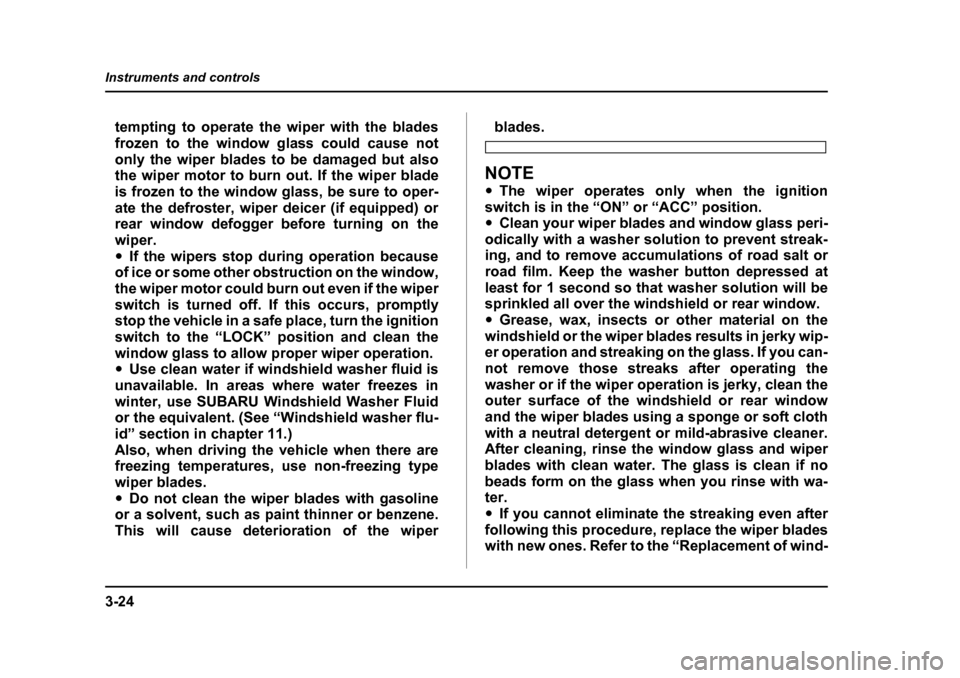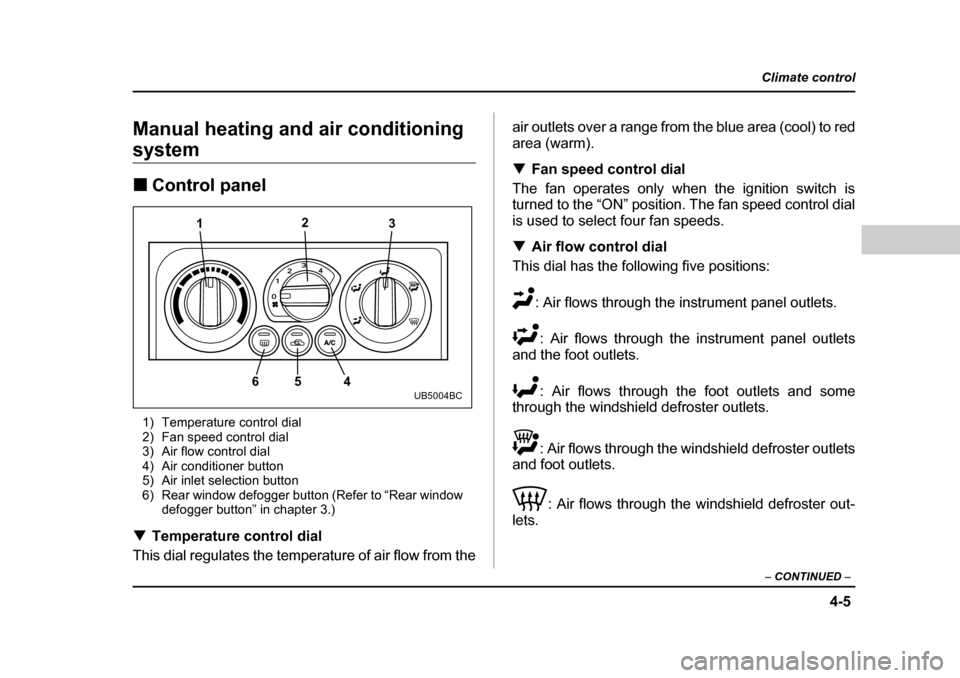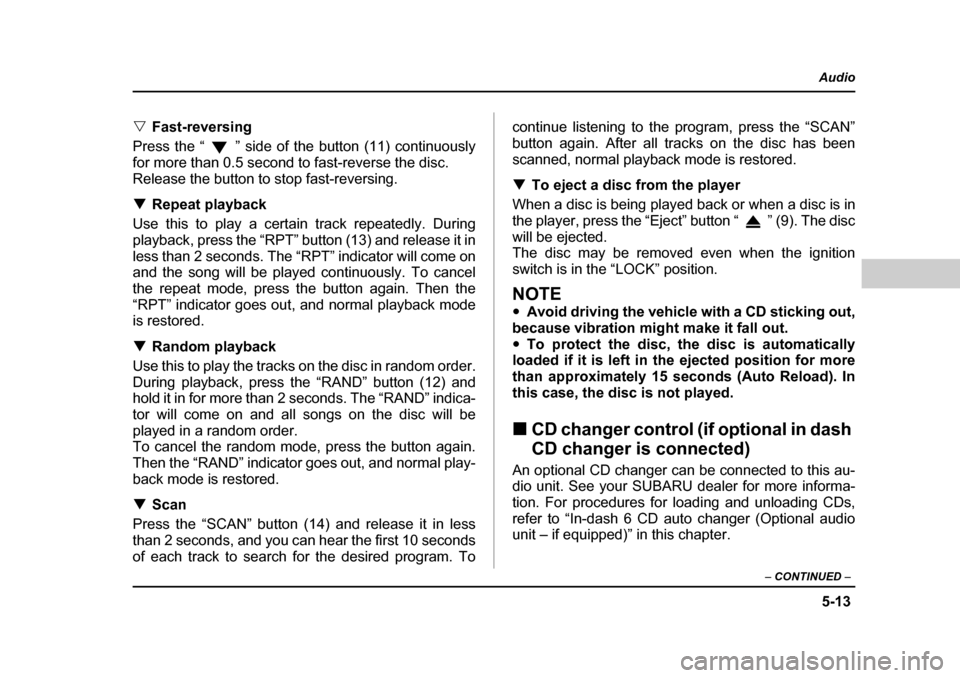Page 147 of 469

3-24
Instruments and controls
tempting to operate the wiper with the blades
frozen to the window glass could cause not
only the wiper blades to be damaged but also
the wiper motor to burn out. If the wiper blade is frozen to the window glass, be sure to oper-
ate the defroster, wiper deicer (if equipped) or
rear window defogger before turning on the
wiper.�y
If the wipers stop during operation because
of ice or some other obstruction on the window,the wiper motor could burn out even if the wiper
switch is turned off. If this occurs, promptly
stop the vehicle in a safe place, turn the ignition
switch to the “LOCK” position and clean the
window glass to allow proper wiper operation. �y Use clean water if windshield washer fluid is
unavailable. In areas where water freezes in
winter, use SUBARU Windshield Washer Fluid
or the equivalent. (See “Windshield washer flu-
id” section in chapter 11.)
Also, when driving the vehicle when there are
freezing temperatures, use non-freezing type
wiper blades.�y Do not clean the wiper blades with gasoline
or a solvent, such as paint thinner or benzene.
This will cause deterioration of the wiperblades.
NOTE �y The wiper operates only when the ignition
switch is in the “ON” or “ACC” position. �y Clean your wiper blades and window glass peri-
odically with a washer solution to prevent streak-
ing, and to remove accumulations of road salt or
road film. Keep the washer button depressed at
least for 1 second so that washer solution will be
sprinkled all over the windshield or rear window. �y Grease, wax, insects or other material on the
windshield or the wiper blades results in jerky wip-
er operation and streaking on the glass. If you can-
not remove those streaks after operating the
washer or if the wiper operation is jerky, clean the
outer surface of the windshield or rear window
and the wiper blades using a sponge or soft cloth
with a neutral detergent or mild-abrasive cleaner.
After cleaning, rinse the window glass and wiper
blades with clean water. The glass is clean if no
beads form on the glass when you rinse with wa-ter. �y If you cannot eliminate the streaking even after
following this procedure, replace the wiper blades
with new ones. Refer to the “Replacement of wind-
Page 150 of 469
3-27
Instruments and controls
– CONTINUED –
To turn on the defogger, push the button. To turn it off,
push the button again.
The indicator light located on the button lights up while
the rear window defogger is operating.
Windshield wiper deicer (if equipped)
To prevent the battery from being discharged,
do not operate the windshield wiper deicer con-
tinuously for any longer than necessary.
The windshield wiper deicer operates only when the
ignition switch is in the “ON” position.
Before turning on the windshield wiper deicer, remove
any snow from the windshield. To turn on the wind-
UB3028BA
UB3029BA
Page 151 of 469
3-28
Instruments and controls
shield wiper deicer, push the button. The indicator light
located on the button lights up while the windshield
wiper deicer is operating.
The windshield wiper deicer will automatically shut off
after about 15 minutes. If the wiper blades have been
deiced completely before that time, push the button to
turn it off. It also turns off when the ignition switch is
turned to the “ACC” or “LOCK” position. If deicing is
not complete when you restart your vehicle, you have
to push the button to turn the deicer on again.Mirrors
Always check that the inside and outside mirrors are
properly adjusted before you start driving. �„
Inside mirror
1) Tab
The inside mirror has a day and night position. Pull the
tab at the bottom of the mirror toward you for the night
position. Push it away for the day position. The night
position reduces glare from headlights.
1HS3036BB
Page 153 of 469

3-30
Instruments and controls
detect it and make the reflection surface of the mirror
dimmer to help prevent you from being blinded. For
this reason, use care not to cover the sensors with
stickers, or other similar items. Periodically wipe the
sensors clean using a piece of dry soft cotton cloth or
an applicator. �V
Compass calibration
1. For optimum calibration, switch off all nonessential
electrical accessories (rear window defogger, heater/
air conditioning system, spotlight, etc.) and ensure all
doors are shut.
2. Drive to an open, level area away from large metal-
lic objects or structures and make certain the ignition
switch is in the “ON” position.
3. Press and hold the left button for 3 seconds then re-
lease, and the compass will enter the calibration
mode. “CAL” and direction will be displayed.
4. Drive slowly in a circle until “CAL” disappears from
the display (about two or three circles). The compass
is now calibrated.
5. Further calibration may be necessary should out-
side influences cause the mirror to read inaccurately.
You will know that this has occurred if your compass
begins to read in only limited directions. Should you
encounter this situation, return to step one of the
above procedure and recalibrate the mirror. �V
Compass zone adjustment
1. The zone setting is factory preset to Zone 8. Refer
to the “Compass calibration zone” map at the end of
this manual to verify that the compass zone setting is
correct for your geographical location.
2. Press and hold the right button for 3 seconds then
release, and the word “ZONE” will briefly appear and
then the zone number will be displayed.
3. Press the right hand button repeatedly to cycle the
display through all possible zone settings. Stop cycling
when the correct zone setting for your location is dis-
played.
4. Releasing the button for 3 seconds will exit the
zone setting mode. �„ Outside mirrors
�T Convex mirror (Passenger side)
Objects look smaller in a convex mirror and far-
ther away than when viewed in a flat mirror. Do
not use the convex mirror to judge the distance
of vehicles behind you when changing lanes.
Use the inside mirror (or glance backwards) to
determine the actual size and distance of ob-
Page 155 of 469
3-32
Instruments and controls
�T
Outside mirror defogger (if equipped)
To prevent the battery from being discharged,
do not operate the defogger continuously for
any longer than necessary.
The outside mirror defogger operates only when the
ignition switch is in the “ON” or “ACC” position.
1) Indicator light
To turn on the outside mirror defogger, push the but-
ton while the engine is running. The indicator light located on the button will come on
when the outside mirror defogger heater in operation.
To turn it off, push the button again.
1
UB4004CB
Page 162 of 469

4-5
Climate control
– CONTINUED –
Manual heating and air conditioning
system �„Control panel
1) Temperature control dial
2) Fan speed control dial
3) Air flow control dial
4) Air conditioner button
5) Air inlet selection button
6) Rear window defogger button (Refer to “Rear window defogger button” in chapter 3.)
�T Temperature control dial
This dial regulates the temperature of air flow from the air outlets over a range from the blue area (cool) to red
area (warm). �T
Fan speed control dial
The fan operates only when the ignition switch is
turned to the “ON” position. The fan speed control dial
is used to select four fan speeds. �T Air flow control dial
This dial has the following five positions:
: Air flows through the instrument panel outlets.: Air flows through the instrument panel outlets
and the foot outlets.
: Air flows through the foot outlets and some
through the windshield defroster outlets.
: Air flows through the windshield defroster outlets
and foot outlets.
: Air flows through the windshield defroster out-
lets.
1
65 42
3
UB5004BC
Page 177 of 469
5-6
Audio
AM/FM radio with CD player
The audio set will operate only when the ignition switch is in the “ACC” or
“ON” position. �„
Radio operation
(1) (2)
(6) (5) (4) (3)
UB5067BB
(1) Power switch/Volume, Tone, Balance, Fader control dial
(2) BAND button
(3) Tuning buttons
(4) Preset buttons
(5) AUDIO button
(6) SCAN button
Page 184 of 469

5-13
Audio
– CONTINUED –
�VFast-reversing
Press the “ ” side of the button (11) continuously
for more than 0.5 second to fast-reverse the disc.
Release the button to stop fast-reversing. �T Repeat playback
Use this to play a certain track repeatedly. During
playback, press the “RPT” button (13) and release it in
less than 2 seconds. The “RPT” indicator will come on
and the song will be played continuously. To cancel
the repeat mode, press the button again. Then the
“RPT” indicator goes out, and normal playback mode
is restored. �T Random playback
Use this to play the tracks on the disc in random order.
During playback, press the “RAND” button (12) and
hold it in for more than 2 seconds. The “RAND” indica-
tor will come on and all songs on the disc will be
played in a random order.
To cancel the random mode, press the button again.
Then the “RAND” indicator goes out, and normal play-
back mode is restored. �T Scan
Press the “SCAN” button (14) and release it in less
than 2 seconds, and you can hear the first 10 seconds
of each track to search for the desired program. To continue listening to the program, press the “SCAN”
button again. After all tracks on the disc has been
scanned, normal playback mode is restored. �T
To eject a disc from the player
When a disc is being played back or when a disc is in
the player, press the “Eject” button “ ” (9). The disc
will be ejected.
The disc may be removed even when the ignition
switch is in the “LOCK” position.
NOTE �y Avoid driving the vehicle with a CD sticking out,
because vibration might make it fall out. �y To protect the disc, the disc is automatically
loaded if it is left in the ejected position for more
than approximately 15 seconds (Auto Reload). In
this case, the disc is not played. �„ CD changer control (if optional in dash
CD changer is connected)
An optional CD changer can be connected to this au-
dio unit. See your SUBARU dealer for more informa-
tion. For procedures for loading and unloading CDs,
refer to “In-dash 6 CD auto changer (Optional audio
unit – if equipped)” in this chapter.